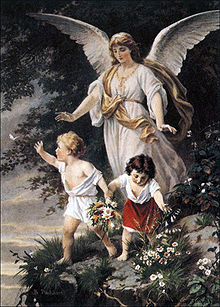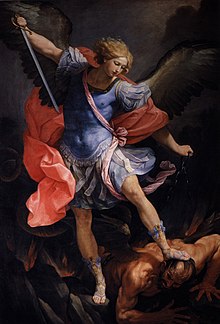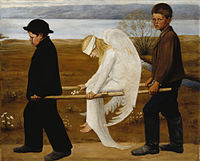


An angel is a spiritual (without a physical body) or heavenly supernatural being.
It is often depicted as a messenger or intermediary between God and humanity in various traditions like the Abrahamic religions.[1][2] Other roles include protectors and guides for humans, such as guardian angels and servants of God.[3]
Abrahamic religions describe angelic hierarchies, which vary by religion and sect. Some angels have specific names (such as Gabriel or Michael) or titles (such as seraph or archangel). Malevolent angels are often believed to have been expelled from Heaven and called fallen angels. In many such religions, the Devil (or devils) are identified with such angels.

Angels in art are often identified with bird wings,[4] halos,[5] and divine light. They are usually shaped like humans of extraordinary beauty, though this is not always the case—sometimes, they can be portrayed in a frightening, inhuman manner.[6]
- ^ The Free Dictionary: "angel" Archived 8 November 2012 at the Wayback Machine, retrieved 1 September 2012
- ^ "Angels in Christianity". Religion Facts. Archived from the original on 6 April 2015.
- ^ Augustine of Hippo's Enarrationes in Psalmos Archived 9 October 2011 at the Wayback Machine, 103, I, 15, augustinus.it (in Latin)
- ^ Proverbio (2007), pp. 90–95; compare review in La Civiltà Cattolica, 3795–3796 (2–16 August 2008), pp. 327–328.
- ^ Didron, Vol 2, pp.68–71.
- ^ Blau, Ludwig; Kohler, Kaufmann. "Angelology". Jewish Encyclopedia. Archived from the original on 20 May 2016. Retrieved 2 May 2016.